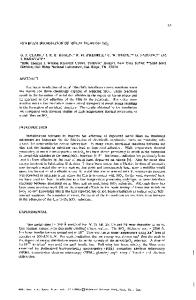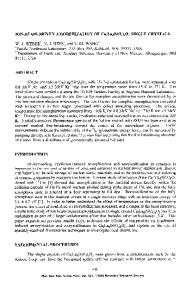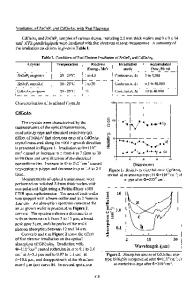Studies of the Effects of Ion-Implantation and Electron Beam Irradiation on CuInSe 2 Single Crystals
- PDF / 2,947,056 Bytes
- 6 Pages / 420.48 x 639 pts Page_size
- 48 Downloads / 342 Views
STUDIES OF THE EFFECTS OF ION-IMPLANTATION AND ELECTRON BEAM IRRADIATION ON CuInSe 2 SINGLE CRYSTALS. C.A.MULLAN, C.J.KIELY, A.ROCKETTt, M.IMANIEH*, M.V.YAKUSHEV* and R.D.TOMLINSON* Department of Materials Science and Engineering, University of Liverpool, England. *Department of Electronic and Electrical Engineering, University of Salford, England. t Coordinated Science Laboratory, University of Illinois at Urbana-Champaign, USA. ABSTRACT A series of CuInSe 2 single crystals which were grown by the vertical Bridgman technique have been implanted with oxygen and xenon ions. These implants tend to cause a change from n to p-type conductivity and an enhancement of the photoconductivity. We present HREM and SIMS characterisation of the microstructural effects caused by high dose ion implants on CuInSe 2 . We also correlate our data with calculated ion implant profiles. In addition, we show that CuInSe 2 thin foils can undergo significant degradation under the electron beam irradiation conditions which are commonly encountered in electron microscopes. INTRODUCTION CuInSe 2 is a member of the I-IIl-IV 2 family of ternary semiconducting compounds which have the chalcopyrite crystal structure. It has been very successfully used as an absorber layer in efficient thin film solar cells because it has a direct band gap material with an extremely high optical absorption coefficient [1]. Its potential use in space photovoltaic power systems has recently prompted fundamental research into the resistance of CuInSe 2 to radiation damage and ion bombardment. The electrical properties of CuInSe 2 are dominated by a complex interplay between compensating populations of intrinsic point defects [2]. A deficiency of Se generally leads to n-type material whereas a Se excess promotes p-type behaviour. In thin films the Cu:In ratio is often varied to control the majority carriers in the material. Calculations suggest that vacancies on the cation sublattice and CuIn antisite defects are largely responsible for the p-type characteristics whereas selenium vacancies and Incu antisite defects are n-type centers[3]. It was recognised by Noufi et. al.[4] that the efficiency of CuInSe 2 thin film solar cells could be significantly increased by annealing in an oxidising atmosphere. They deduced that oxygen was being incorporated in the vicinity of grain boundaries in thin film material. This prompted Tomlinson et. al. [5] to study the effect of introducing controlled amounts of oxygen to the near-surface regions of n-type CuInSe 2 single crystals by ion implantation. They found that the oxygen implant caused a near-surface n to p-type conversion and greatly enhanced the photoconductive response of the material by a factor of 100. The oxygen, which is itself electrically active in CuInSe 2 , serves to remove donor states (possibly by substituting for Se) and thereby alters the balance of compensating defects in favour of the acceptor state population. The optical sensitization which accompanies oxygen implantation into both n and p-type CuInSe 2 has
Data Loading...











